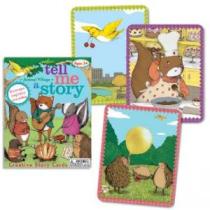 Age level: Preschool
Age level: Preschool
Description: Tell Me A Story is a product put by Eeboo that is described as “Creative Story Cards.” It includes 36 cards with pictures of animals involved in a variety of activities. It includes instructions for three different games: Your Child Tells a Story, Silly Story Game, Tell Your Child a Story. I have the Animal Version, but Eeboo currently has five other versions so you can find the topic that might be most motivating to your learner.
Skills & Modifications: Because these are just cards with pictures on them, it is very easy to use them for a variety of activities. The biggest modification I make to this game is to use the cards independently, instead of using multiple cards together as the game instructions suggest. However, for some students I will follow the instructions included with the game. It should be noted that the first three skills listed (picture comprehension, adjectives, and tacting) all describe activities that work on expressive language skills.
- Picture Comprehension – This is an instance in which I would use just one card. I will ask my student Wh- questions about what is in the picture, or I may just ask them to “Tell me about the picture.”
- Adjectives – This is similar to the picture comprehension, except that instead of asking the student to tell me about the picture, I will ask them to tell me about or describe an item in the picture. You can also use it to have a student select for adjectives. For example, in a picture showing multiple animals, I might say “Show me the brown animal.”
- Scanning – This is a great activity for students who are doing well with scanning, but aren’t quite at a “Where’s Waldo” level. I will put out a picture and ask them to find something, such as “Can you show me the bird?” To make it more difficult, I’ll put out a few cards in a messy array on the table and ask them to find a single object.
- Tacting (Labeling) – This is great for your students who are doing higher-level tacting, or (if you are using the VB-MAPP to assess and guide instruction) are doing higher-level Match-to-Sample skills. Because this is not simply one object on a blank background, it will help challenge those students who still need practice with labeling.
- Recalling A Story – For some students, I will make up a brief story about one or more cards. I will then ask them to retell it to me. The cards can be used as visual prompts to help guide them, or they can removed from visibility.
- Story Structure – This is a great tool for practicing story structure, and is one of the purposes the game was designed for. I will put out three cards. Sometimes I may use a textual prompt by placing labels below each card as beginning, middle, end. Then we will create a story together with a focus on the structure.
- Sequencing – For sequencing, I may tell my student a story without the cards present. Then I will give him the cards and ask him to put them in the correct order based on the story I described.
- Problem & Solution – For many students, I will pose a problem and have them work try to come up with a solution. (For example, with Mickey Mouse figurines, I may act out a scenario as Goofy, and tell the student that I am hungry. The student has to figure out how we can solve it. As students begin to master this concept, I will sometimes deny their solution and ask them to come up with another one.) These pictures lend themselves nicely to practicing this skill with different materials. For example, one of the pictures shows a cat about to steal candy from a bowl on the kitchen table. I will ask the student what the problem is, then ask him how we could solve it.
- Foreground & Background – Some students with autism and other developmental delays may struggle with processing information from both the foreground and background. Many of the cards in this deck are useful for practicing those skills as there are details in the background (such as a plane seen flying in the sky through the kitchen window.)
Pros: The deck of cards is relatively inexpensive and done well. It can be used to practice a wide range of skills for a variety of early learners, and is frequently highly motivating to students.
Cons: If you have older learners that are struggling with the skills listed above, Tell Me A Story is not age-appropriate. I wish they would create something similar that would be geared towards older learns who are struggling.
Cost: $9.95 Should I buy this? I think it’s a great purchase if you teach preschoolers or have preschool-aged children.
ABLLS: C17, C20, C24, C38, C43, C44, G4, G6, G8, G13, G40
VB-MAPP: Tact 5, Tact 6, Listener Responding 10, Tact 13
Reblogged this on ENGLISH LANGUAGE REVIEW .